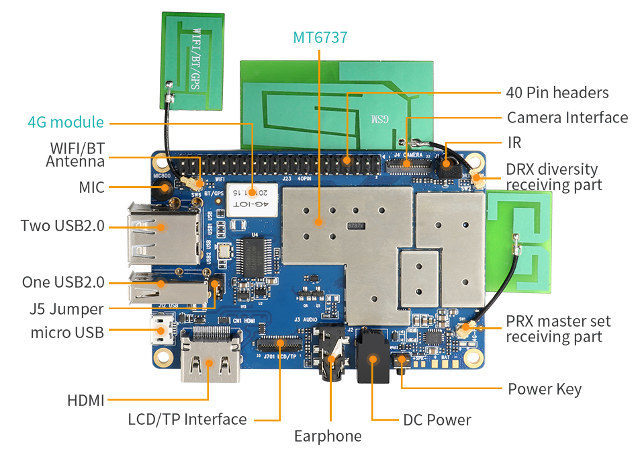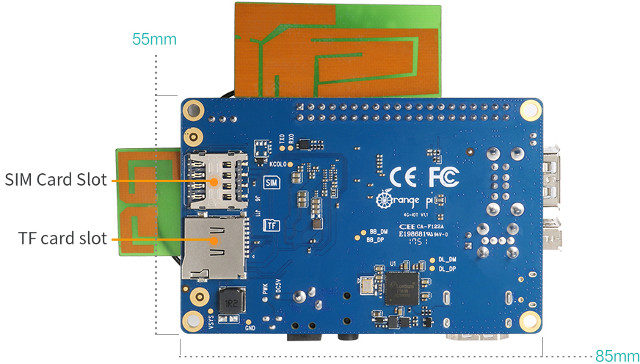Last year, Shenzhen Xunlong Software launched Orange Pi 2G-IoT board for just $9.90. Pricing was incredibly aggressive for a cellular board, but AFAIK the RDA Micro processor used in the design had never been used with Linux so for many people using the board was a challenge (and maybe still is), and some countries have already started to sunset 2G networks.
So it only made sense for the company to work on a 4G board, and that’s exactly what they have done with Orange Pi 4G-IoT now launched for $45 + shipping on Aliexpress.

Orange Pi 4G-IoT specifications:
- SoC – Mediatek MT6737 quad core Cortex A53 processor @ 1.1/1.3 GHz with Arm Mali-T720MP1 GPU
- System Memory – 1GB DDR3
- Storage – 8GB eMMC flash + micro SD slot
- Video Output – HDMI, LCD display interface with touch panel support
- Audio – 3.5mm earphone jack, built-in microphone
- Cellular Connectivity
- nano SIM card slot
- “GSM” antenna + diversity antenna
- 2G – GSM @ 850/900/1800/1900 MHz
- WCDMA – B1/B2/B4/B5/B8
- TD-CDMA
- CDMA2000
- LTE Cat 4 [Update May 2018: The bands listed below may not be fully correct, waiting for details]
- FDD-LTE – B1/B2/B3/B4/B7/B107/B20
- TDD-LTE – B38/40/41B
- Connectivity – WiFi, Bluetooth, FM, and GPS with antenna
- Camera – 25-pin ZIF connector for 13MP camera
- USB – 3x USB host ports, 1x micro USB port (only for flashing firmware)
- Sensors – Accelerometer, fingerprint (how?)
- Expansion – 40-pin header with 2x SPI, 3x I2C, 2x UART, 1.8V
- Misc – IR receiver, power key, power and status LEDs
- Power Supply – 5V/2A via power barrel jack; battery support through “weld plate”
- Dimensions – 85 x 55 mm
 Mediatek MT6737 is a low cost LTE application processor for smartphone, so it’s no surprise the board can run Android 6.0, but for now at least there’s no word about Linux support. As usual, an Orange Pi board with a new processor (in dev boards) should only be suitable for the most adventurous among us 🙂
Mediatek MT6737 is a low cost LTE application processor for smartphone, so it’s no surprise the board can run Android 6.0, but for now at least there’s no word about Linux support. As usual, an Orange Pi board with a new processor (in dev boards) should only be suitable for the most adventurous among us 🙂

Jean-Luc started CNX Software in 2010 as a part-time endeavor, before quitting his job as a software engineering manager, and starting to write daily news, and reviews full time later in 2011.
Support CNX Software! Donate via cryptocurrencies, become a Patron on Patreon, or purchase goods on Amazon or Aliexpress





FDD B2 and B4 — this might actual work in the USA on AT&T, Verizon, T-Mobile.
I ordered one. I have been looking for a phone chassis to OEM for a long time and none of the phone chip vendors would talk to us.
I found the CPU manual.
https://drive.google.com/file/d/1X3iKl8Kx_eqfqYqAA-Qwe3rzDSseLM2x/view?usp=sharing
I wonder if Freeswitch GSM-Open module will be able to run on this. I used it with an Huawei dongle to route calls through VoIP:
https://freeswitch.org/confluence/display/FREESWITCH/mod_gsmopen
Video in this chip is useless – encode 720P MPEG4 at 15Mb/s. No h.264 encode support.
What is the point in having dual 8MP MIPI camera support with no ability to encode it?
Maybe this is a MT6737T? It supports 30FPS 1080P h.264.
Wow, LTE, crazy.
What’s current usage for the board?
Jon Smirl, machine vision or surveillance, perhaps? Not everything is about television.
Not directly related for here’s a list of cellular development boards -> https://www.cnx-software.com/2018/03/26/a-list-of-cellular-iot-development-boards/
The most useful list I have seen on internet. thanks a lot ! Do share what board you are using for your IOT
No battery support is a huge fail, just like with 2G-IOT. Whats the point of such board, if you can’t power it via battery ?
There’s battery support, but you’d need to solder the battery. See pads on bottom right of top picture.
I’ll believe this when i see it tested. 2G-IOT also had pads for battery, but it turned out there is no hardware (step up regulators for one) to support this, just pads for show.
I want to be able to use the camera to remotely view what the device is seeing. The encoder on this chip is too poor to handle reasonable remote viewing of the video. This chip needs 15Mb/s bandwidth for the camera. An h.264 stream only needs about 2Mb/s. They need to switch over to the MT6737T to get a modern h.264 video encoder, not MPEG4 from 2002.
I’m not sure where you’re getting this information, but according to MediaTek’s own website (and my own experience) it can encode h264 at at least 720p60
I’ve just double checked with Shenzhen Xunlong, they confirmed they are using MT6737, not MT6737T.
Will they switch onto the MT6737T in the next batch they make?
If you have a potential project that would work with MT6737T maybe you could try to talk to Steven to see what he can do.
mt6737:
Video Encoding: MPEG-4
Video Encoding FPS: 30 @ 720p
You must have the MT6737T version which can do h.264
parrotgeek1, do you have a MT6737 or a MT6737T?
I guess this is another rubbish without CE/FCC…
Well good they innovate but Orange Pi always lets themselves down, on software and after support.
Also now they have given themselves two mobile SoC to support, 2g -IoT Soc and this 4G IoT Soc.
My 4G-IOT board has arrived. I powered it on an hooked it to an HDMI monitor. Four monitors later I found one that will work with the odd 720P mode it defaults to. This default needs to be changed to a more common 1080P mode. I have not verified cellular yet since it takes a mini-SIM card and I had to order one. Mouse and keyboard work from the USB port. It is likely that USB Ethernet will also work, but I did not try,
I did download the Android 6 source and it does build and produce an image. I have not tried reflashing the device yet. It implements some Mediatek UI, not the normal Android one. A first project would be to remove the Mediatek UI. Kernel is ancient 3.18 which was EOL in January 2017.
No schematics have been posted yet so I am unsure of what the hardware does. Initially USB OTG did not work and I just guessed and removed J5 to make it work. Once I had adb working I was able to look inside and verify that it really is a MT6737 (not T) and it only has crummy MPEG video encode support (from 2002).
OrangePi has promised a release of Android 8 soon. So I don’t know if I will mess with this Android 6 much. I’d rather work on the newer source.
For my purposes this is just a demo board since it is lacking reasonable camera support. The IOT devices I work on are all cameras.
Ran CPU-Z and found that the board is based on MT6735 with 2GB ram and 16GB rom. Tried H264 encode using mediacodec and surprisingly it supports AVCProfileHigh AVCLevel3.
I am wondering if this is a mt6637v which I have zero info on. I don’t want to unsolder the sheild and look. /Proc/cpuinfo says it is mt6737
I meant MT6737V
As per “Orange Pi 4G-IOT_V1.1_Schematic.pdf” the soc is based on MT6735
I believe those are just generic schematics and do not accurately reflect the board. For example the LTE filters in the schematics are for China and the board is supposed to support US and EU bands too.
Did it actually encode the video? Or just a report saying encoding was available?
Does cpu-z just report what the programmer told it too, for ages it reported Amlogic SoC as 2GHz.
Yes, CPU-Z is not the most reliable source of information to get the CPU model. It relies on the database on the program. For example, I think most Rockchip processors (RK3288, RK3399…) are still shown as RK3066 (TBC).
Yes it did, i do not have a compatible display so I used https://github.com/amitv87/remote_access/tree/master/android to control it from my browser.
You can check for the profile constants here https://developer.android.com/reference/android/media/MediaCodecInfo.CodecProfileLevel
OMX.MTK.VIDEO.ENCODER.AVC
profile/level: 1/1
profile/level: 1/2
profile/level: 1/4
profile/level: 1/8
profile/level: 1/16
profile/level: 1/32
profile/level: 1/64
profile/level: 1/128
profile/level: 1/256
profile/level: 8/1
profile/level: 8/2
profile/level: 8/4
profile/level: 8/8
profile/level: 8/16
profile/level: 8/32
profile/level: 8/64
profile/level: 8/128
profile/level: 8/256
guess this is soft encoder
OMX.google.h264.encoder
profile/level: 1/1
profile/level: 1/2
profile/level: 1/4
profile/level: 1/8
profile/level: 1/16
profile/level: 1/32
profile/level: 1/64
profile/level: 1/128
profile/level: 1/256
profile/level: 1/512
profile/level: 1/1024
profile/level: 1/2048
profile/level: 1/4096
profile/level: 2/1
profile/level: 2/2
profile/level: 2/4
profile/level: 2/8
profile/level: 2/16
profile/level: 2/32
profile/level: 2/64
profile/level: 2/128
profile/level: 2/256
profile/level: 2/512
profile/level: 2/1024
profile/level: 2/2048
profile/level: 2/4096
Another one, but more expensive (Amlink M100)
https://shop159653367.world.taobao.com/index.htm
We are trying to get info on this module for $19.
https://detail.1688.com/offer/555199524149.html?spm=b26110380.sw1688.mof001.67.543c58701WKk4Z
This Amlink M100 is $55 which is $10 more than the 4G-IOT ($45) which contains at least $7 more worth of extra hardware (antennas, HDMI converter support, USB hub, GPIO header, etc).
Orange Pi 3G-IOT is coming with MT6572 + 256MB DDR2+512MB EMMC or 512MB DDR2+ 4GB EMMC
5.5″ touchscreen display for Orange Pi 4G-IoT. Price: $19.80 + shipping
https://www.aliexpress.com/store/product/Orange-Pi-4G-IOT-5-5inch-Black-color-TFT-LCD-Touch-Screen/1553371_32895240070.html
They actual have complete sets with Orange Pi 3G-IoT or 4G-IoT plus display which should be cheaper than buying the items individually -> https://www.aliexpress.com/store/1553371/search?origin=y&SearchText=Touch+screen
There are a lot of finished phone on the market using this MT6737 CPU:
https://www.kimovil.com/en/compare-smartphones/f_dpg+id.87
The Nokia 1 ($110) is easy to disassemble and it has US bands.
https://www.kimovil.com/en/where-to-buy-nokia-1
Personally I prefer the Umidigi A1 which uses the more recent MT6739 (support is in the OrangePi Mediatek code).
https://www.kimovil.com/en/where-to-buy-umidigi-a1-pro
$100, US bands, better screen, camera, etc.
For the stuff I am working on it is probably better to use a finished phone which has real FCC, CE, etc approval. And is running a Google GMS certified image with monthly updates. You can then use USB to attach external hardware.
This is a neat piece of code.
https://github.com/gibsson/linux-adk
Your build your custom hardware as a USB host. When you plug the off-the-shelf phone into it, this code will trigger your app to run on the phone. Now you can use USB to talk to this app from your custom hardware. Plus since the phone is in device mode you can supply power to it.
Hi Jon
What stops people just using a phablet if you require a bigger screen?
https://www.aliexpress.com/item/Cubot-J3-PRO-4G-Phablet-5-5-Inch-Android-GO-MT6739-Quad-Core-1-5GHz-1GB/32882099240.html?
It has Chinese LTE bands – FDD-LTE B1 /B3 /B7 /B8 /B20. I think those bands work with one EU carrier. Needs B2/B4 at a minimum for USA. Umidigi A1 and Nokia 1 have US LTE bands. On kimovil you can put in the country you are living in and it will tell you if the phone is compatible with carriers in that country. 4G-IOT has same problem, the bands it supports don’t work in the USA.
MT6739 performance is way better than MT6737. I have one of each phone and it is obvious which one is faster. I can barely use the MT6737 without consciously considering how slow it is and then using the touchscreen more slowly to give it more time to respond.
Hello,
Someone can tell me how it works the GPS module? is ok?
And what about accelerometer? is really or fake? works well?